The greatest potential for conflict over battery metals may not be in Asia, Africa or the Americas, write Stan Cox and Priti Gulati Cox. It may not be on any continent at all.
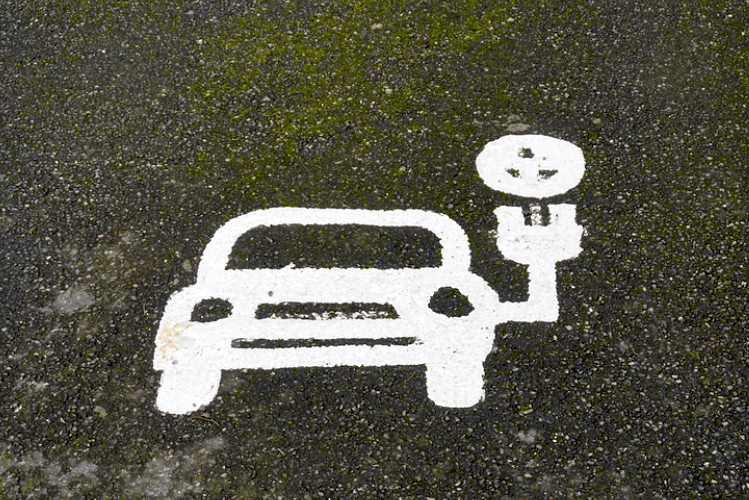
(RawPixel, Public Domain)
By Stan Cox and Priti Gulati Cox
TomDispatch.com

 Much of the excitement over the Inflation Reduction Act, which became law this summer, focused on the boost it should give to the sales of electric vehicles. Sadly, though, manufacturing and driving tens of millions of individual electric passenger cars won’t get us far enough down the road to ending greenhouse-gas emissions and stanching the overheating of this planet. Worse yet, the coming global race to electrify the personal vehicle is likely to exacerbate ecological degradation, geopolitical tensions and military conflict.
Much of the excitement over the Inflation Reduction Act, which became law this summer, focused on the boost it should give to the sales of electric vehicles. Sadly, though, manufacturing and driving tens of millions of individual electric passenger cars won’t get us far enough down the road to ending greenhouse-gas emissions and stanching the overheating of this planet. Worse yet, the coming global race to electrify the personal vehicle is likely to exacerbate ecological degradation, geopolitical tensions and military conflict.
The batteries that power electric vehicles are likely to be the source of much international competition and the heart of the problem lies in two of the metallic elements used to make their electrodes: cobalt and lithium. Most deposits of those metals lie outside the borders of the United States and will leave manufacturers here (and elsewhere) relying heavily on foreign supplies to electrify road travel on the scale now being envisioned.
Adventurers & Opportunists
In the battery business, the Democratic Republic of Congo is referred to as “the Saudi Arabia of cobalt.” For two decades, its cobalt — 80 percent of the world’s known reserves — has been highly prized for its role in mobile-phone manufacturing. Such cobalt mining has already taken a terrible human and ecological toll.
Now, the pressure to increase Congo’s cobalt output is intensifying on a staggering scale. Whereas a phone contains just thousandths of a gram of cobalt, an electric vehicle battery has pounds of the metal, and a quarter-billion such batteries will have to be manufactured to fully electrify the American passenger car fleet as it now exists.

The Boulevard du 30 Juin, a major artery to the business district in Gombe, Kinshasa, DRC, 2010. (MONUSCO/Myriam Asmani, CC BY-SA 2.0, Wikimedia Commons)
Not surprisingly, the investment world is now converging on Congo’s capital, Kinshasa. In a remarkable series of articles late last year, The New York Times reported on how the cobalt rush in that country has been caught up “in a familiar cycle of exploitation, greed, and gamesmanship that often puts narrow national aspirations above all else.”
The most intense rivalry is between China, which has, in recent years, been buying up cobalt-mining operations in Congo at a rapid clip, and the United States, now playing catch-up. Those two nations, wrote the Times, “have entered a new ‘Great Game’ of sorts,” a reference to the 19th-century confrontation between the Russian and British Empires over Afghanistan.
Fifteen of 19 cobalt mines in Congo are now under Chinese control. In and around those mines, the health and the safety of workers have been severely compromised, while local residents have been displaced from their homes. People sneaking into the area to collect leftover lumps of cobalt to sell are being shot at. The killing of one man by the Congolese military (at the urging of Chinese mine owners) spurred an uprising in his village, during which a protester was also shot and killed.
The Times further reported, “Troops with AK-47s were posted outside the mine this year, along with security guards hired from a company founded by Erik Prince.”
Prince is notorious for having been the founder and boss of the mercenary contractor Blackwater, which committed atrocities during America’s “forever wars” of the 2000s. Among other mayhem, Blackwater mercenaries fired upon unarmed civilians in both Iraq and Afghanistan and were convicted of the killings and woundings that resulted. From 2014 to 2021, he was the chair of a China-based company, Frontier Services Group, that provided Blackwater-style services to mining companies in Congo.
Prince has joined what the Times calls “a wave of adventurers and opportunists who have filled a vacuum created by the departure of major American mining companies, and by the reluctance of other traditional Western firms to do business in a country with a reputation for labor abuses and bribery.”
Neo-Conquistadors

Erik Prince in 2015. (Miller Center, CC BY 2.0, Wikimedia Commons)
Forbes reported recently that 384 additional mines may be needed worldwide by 2035 to keep battery factories supplied with cobalt, lithium and nickel. Even were there to be a rapid acceleration of the recycling of metals from old batteries, 336 new mines would still be needed.
A battery-industry CEO told the magazine: “If you just look at Tesla’s ambition to produce 20 million electric vehicles a year in 2030, that alone will require close to two times the present global annual supply [of those minerals] and that’s before you include VW, Ford, GM, and the Chinese.”
Currently, the bulk of the world’s lithium production occurs in Australia, Chile and China, while there are vast unexploited reserves in the southern part of Bolivia where it joins Chile and Argentina in what’s come to be known as the “lithium triangle.” China owns lithium mines outright throughout that triangle and in Australia, and two-thirds of the world’s lithium processing is done in Chinese-owned facilities.
Lithium extraction and processing is not exactly a green business. In Chile’s Atacama Desert, for instance, where lithium mining requires vast evaporation ponds, a half million gallons of water are needed for every metric ton of lithium extracted. The process accounts for 65 percent of the total amount of water used in that region and causes extensive soil and water contamination, as well as air pollution.
While evidently uninterested in Mother Nature, Tesla’s electric car tycoon Elon Musk is intensely interested in vertically integrating lithium mining with electric battery and vehicle production on the Chinese model. Accordingly, he’s been trying for years to get his hands on Bolivia’s pristine lithium reserves. Until ousted in a 2020 coup, that country’s President Evo Morales stood in Musk’s way, pledging to “industrialize with dignity and sovereignty.”
When a Twitter user accused Musk of being complicit in the coup, the Tesla tycoon responded, “We will coup whoever we want! Deal with it.” (He later deleted the tweet.) As Vijay Prashad and Alejandro Bejarano observed at the time, “Musk’s admission, however intemperate, is at least honest… Earlier this year, Musk and his company revealed that they wanted to build a Tesla factory in Brazil, which would be supplied by lithium from Bolivia; when we wrote about that we called our report ‘Elon Musk Is Acting Like a Neo-Conquistador for South America’s Lithium.’”
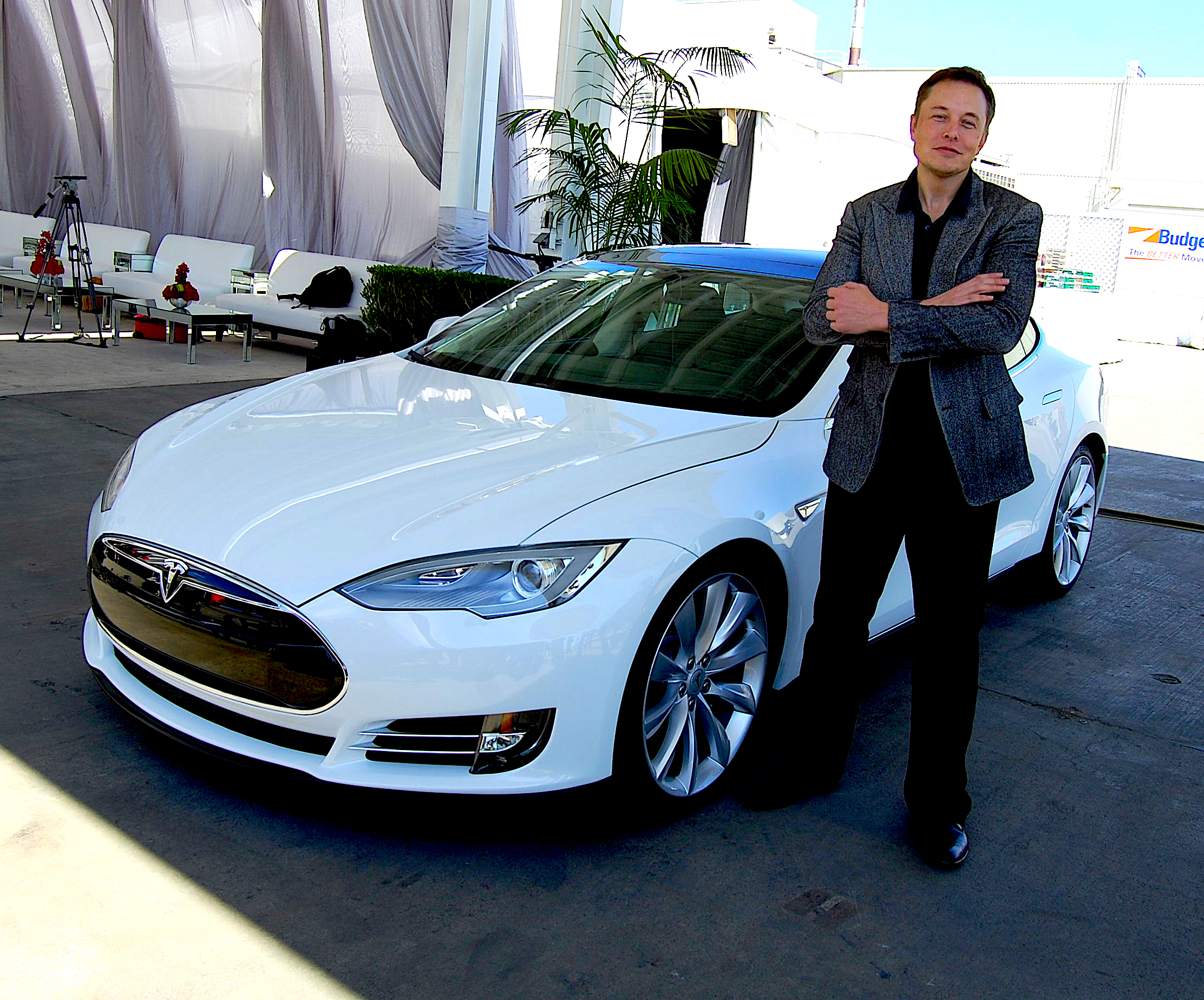
Elon Musk at a Tesla factory in Fremont, California, 2011. (Maurizio Pesce, CC BY 2.0, Wikimedia Commons)
Bolivia continues to seek to exploit its lithium resources while keeping them under national control. Without sufficient wealth and technical resources, however, its government has been obliged to solicit foreign capital, having narrowed the field of candidate companies to six — one American, one Russian, and four Chinese. By year’s end, it’s expected to select one or more of them to form a partnership with its state-owned firm, Yacimientos de Litios Bolivianos. No matter who gets the contract, friction among the three suitor nations could potentially kick off a Western Hemispheric version of the Great Game.
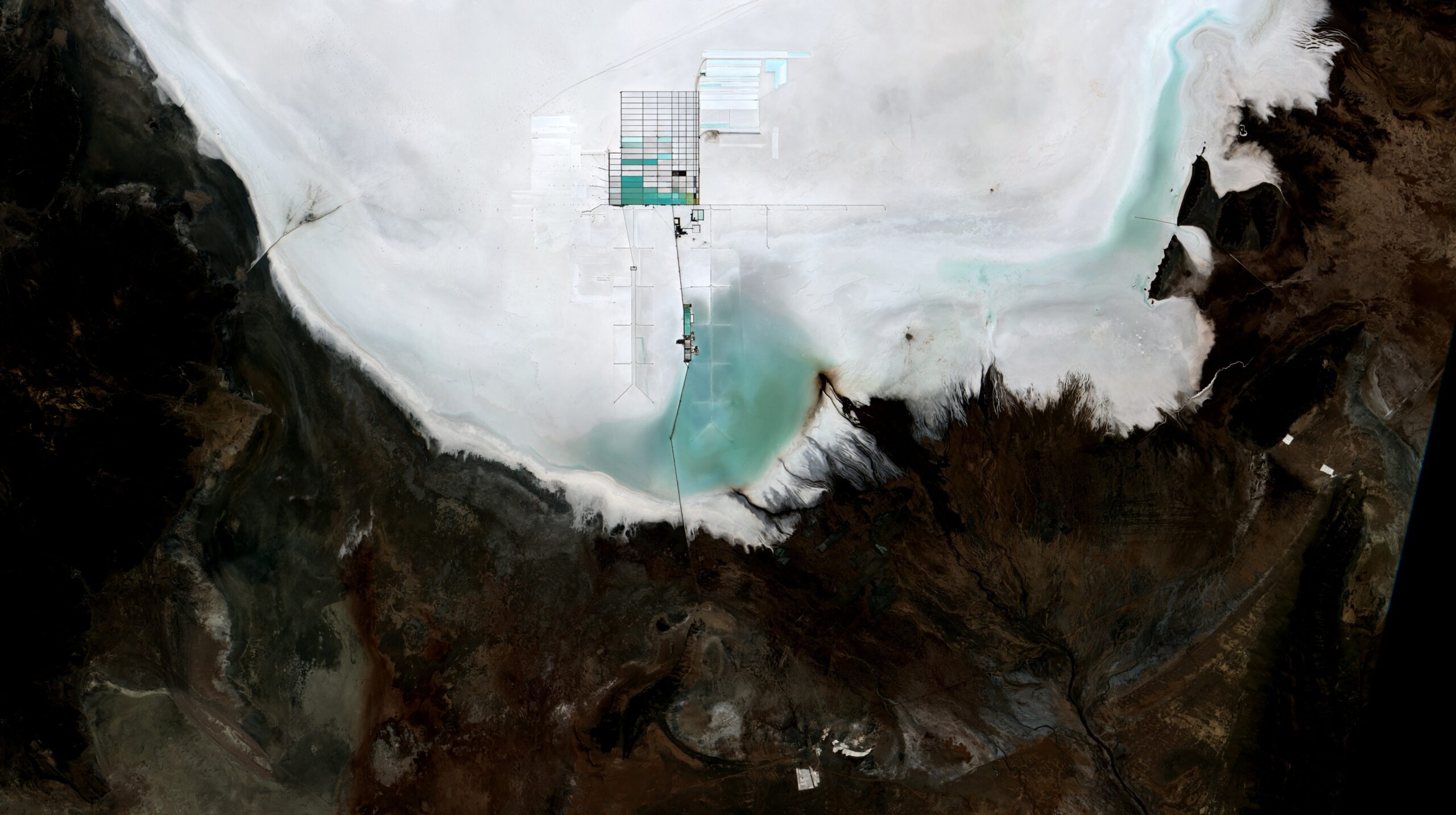
Lithium mine in Bolivia’s Uyuni salt desert, June 2018. Salt evaporation and concentration pools, part of the lithium extraction process, appear in a grid pattern. (Coordenação-Geral de Observação da Terra, CC BY-SA 2.0, Wikimedia Commons)
And whatever you do, don’t forget that Taliban-controlled Afghanistan, a lithium-rich land with centuries of bitter experience in hosting great powers, is another potential arena for rivalry and conflict. In fact, Soviet invaders first identified that country’s lithium resources four decades ago.
During the U.S. occupation of Afghanistan in this century, geologists confirmed the existence of large deposits, and the Pentagon promptly labeled the country — you guessed it — a potential “Saudi Arabia of lithium.” According to the Asia-Pacific-based magazine The Diplomat, the lithium rush is now on there and “countries like China, Russia, and Iran have already revealed their intentions to develop ‘friendly relations’ with the Taliban,” as they compete for the chance to flaunt their generosity and “help” that country exploit its resources.
Don’t Look Down

Imagery of the deep ocean floor in the southwest Pacific Ocean, south of the Samoan Islands, 2004. (Oregon State University, Flickr, CC BY-SA 2.0)
The greatest potential for conflict over battery metals may not, in fact, be in Asia, Africa, or the Americas. It may not be on any continent at all. The most severe and potentially most destructive future battleground may lie far out in international waters, where polymetallic nodules — dense mineral lumps, often compared to potatoes in their size and shape — lie strewn in huge numbers across vast regions of the deep-ocean floor. They contain a host of metallic elements, including not only lithium and cobalt but also copper, another metal required in large amounts for battery manufacturing. According to a United Nations report, a single nodule field, the 1.7 million-square-mile Clarion-Clipperton Zone (CCZ) in the Pacific Ocean southeast of the Hawaiian Islands, contains more cobalt than all terrestrial resources combined.
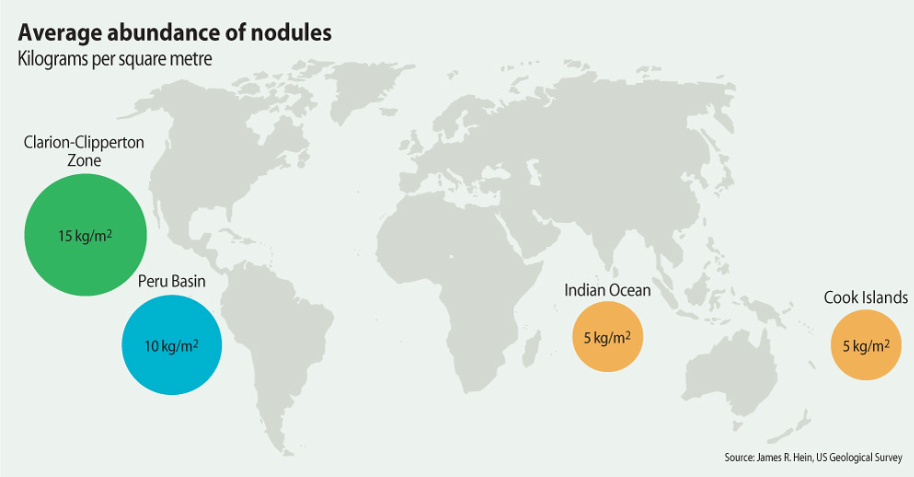
2014 infographic of estimates of average polymetallic nodule abundance in four major locations.(GRID-Arendal, Flickr)
(Original image source for Average abundance of nodules infographic.)
A U.N. agency, the International Seabed Authority, issues exploration licenses to mining companies sponsored by national governments and intends to start authorizing nodule extraction in the CCZ as soon as next year. Mining methods for polymetallic nodules have not yet been fully developed or used on a large scale, but the metal hunters are advertising the process as being far less destructive than the terrestrial mining of cobalt and lithium. One can get the impression that it will be so gentle as not even to be mining as we’ve known it, but something more like running a vacuum cleaner along the seafloor.
Don’t believe it for a second. In just a small portion of the CCZ, scientists have identified more than 1,000 animal species and they suspect that at least another thousand are also living there, along with 100,000 microbial species. Virtually all of the creatures in the path of mining operations will, of course, be killed, and anything living on the surface of those nodules removed from the ecosystem. The nodule-harvesting machines, as large as wheat combines, will stir up towering clouds of sediment likely to drift for thousands of miles before finally settling onto, burying, and so killing yet more sea life.
To recap: America, the Saudi Arabia of green greed, now covets a couple of metals critically important to the electric-vehicle industry, cobalt and lithium, the reserves of which are concentrated in only a small number of nations. However, the ores can also be sucked straight off the seabed in humongous quantities in places far outside the jurisdiction of any nation. Environmentally, geopolitically, militarily, what could possibly go wrong?
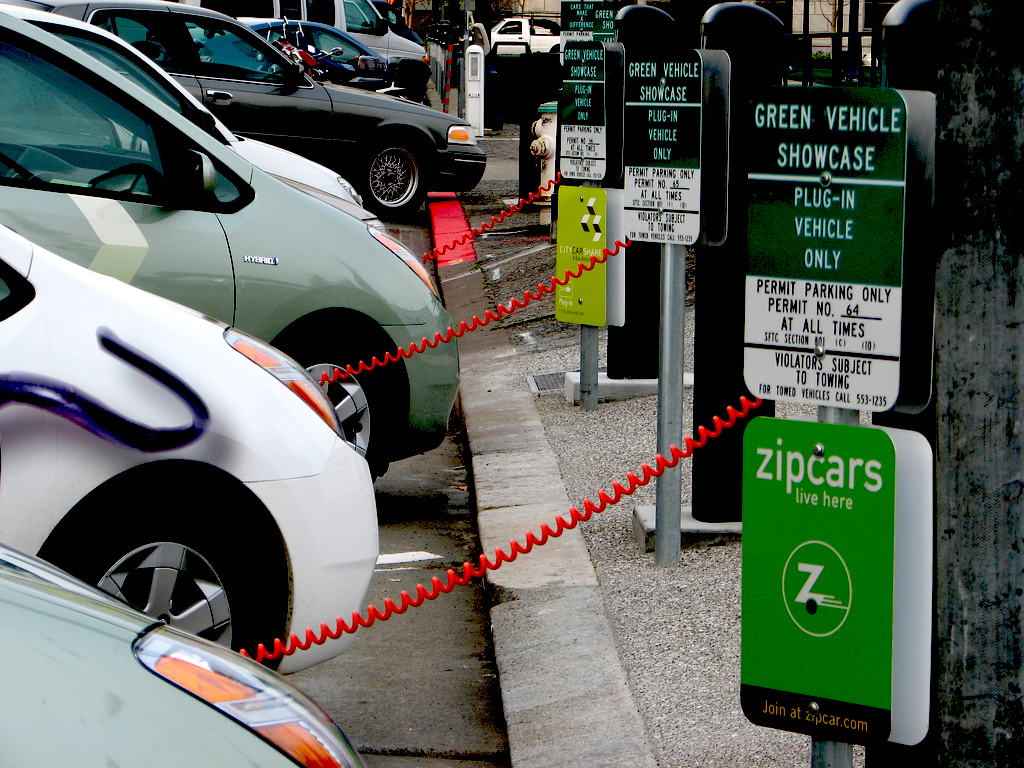
Prius plug-in hybrids charging at San Francisco City Hall, 2009. (Felix Kramer, CalCars, CC BY-SA 2.0, Wikimedia Commons)
Plenty, of course. Writing for the Center for International Maritime Security last year, U.S. Coast Guard Surface Warfare Officer Lieutenant Kyle Cregge argued that the Coast Guard and Navy should have a high-profile presence in seabed mining areas. He stressed that the 1980 Deep Seabed Hard Mineral Resource Act “claimed the right of the U.S. to mine the seabed in international waters, and specifically identifies the Coast Guard as responsible for enforcement.”
He did acknowledge that patrolling areas where deep-sea mining occurs could create some dicey situations. As he put it, “The Coast Guard will face the same problem the U.S. Navy does with its freedom of navigation operations in places like the South China Sea.” But by potentially putting their vessels in harm’s way, he wrote, “the services seek to reinforce the United Nations Convention on the Law of the Sea as reflecting customary international law.” (Forget the fact that the U.S. has never signed onto the Law of the Sea treaty!) Cregge then predicted that, “[a]mong the most challenging in a future seabed competition would be China and Russia, states that have already used lawfare in the South China Sea and Arctic regions respectively to pursue their territorial gains.”
To make matters worse, seafloor mining might not only spark military conflict but also become an integral part of warfighting itself. Manabrata Guha, a researcher in war theory at the University of New South Wales, told Australia’s ABC television that data, including topographic or thermal maps of the seabed, obtained through exploration of the seafloor by mining operations projects, could be of great value to a nation’s armed forces. According to ABC,
“Just 9 percent of the ocean floor is mapped in high resolution, compared to about 99 percent of the surface of Mars — a blind spot that affects both deep sea miners and military planners. This is all worth keeping in mind, because while the Pacific Ocean is set to be the sea with the most mining potential, it is also home to this century’s most consequential geopolitical tension: the rise of China, and the U.S.’s response to it.”
The resource-rich South China Sea in particular, notes ABC, has long been a potential flashpoint between China and America. As Guha speculated, U.S. use of deep-sea data in the region “could be expanded beyond its battle-centric focus to also include attacks on civilian infrastructure, finance, and cultural systems.” He added, “The undersea domain provides another vector, another potential ‘hole’ that the Americans would look to penetrate,” thanks to the fact, as he pointed out, that the U.S. is 20 to 30 years ahead of China in undersea-mapping technology.
“You want to pick and choose where you hurt the adversary to such an extent that their whole system collapses,” he said. “That’s the idea of multi-domain warfare… the idea is to bring about systemic collapse.”
The Burden of the Big-Ass Truck
Systemic collapse? Really? Instead of devising technologies to take down other societies, in this increasingly heated moment, shouldn’t we be focusing on how to avoid our own systemic collapse?
A national fleet of battery-powered cars is unlikely to prove sustainable and could have catastrophic consequences globally. It’s time to consider an overhaul of the whole transportation system to move it away from a fixation on personal vehicles and toward walking, pedaling, and a truly effective nationwide public transportation system (as well as very local ones), which could indeed be run on electricity, while perhaps helping to avoid future disastrous resource wars.
Such a transformation, even were it to occur, would, of course, take a long time. During that period, electric vehicles will continue to be manufactured in quantity. So, for now, to reduce their impact on humanity and the Earth, America should aim to produce fewer and far smaller vehicles than are currently planned. After all, electrified versions of the big-ass trucks and SUVs of the present moment will also require bigger, heavier batteries (like the one in the F-150 Lightning pickup truck, which weighs 1,800 pounds and is the size of two mattresses). They will, of course, contain proportionally larger quantities of cobalt, lithium, and copper.
The true burden of a massive battery in an electric car or truck will be borne not just by the vehicle’s suspension system, but by the people and ecosystems unlucky enough to be in or near the global supply chain that will produce it. And those people may be among the first of millions to be imperiled by a new wave of geopolitical and military conflicts in what should be thought of as the world’s green sacrifice zones.
Stan Cox, a TomDispatch regular, is a research fellow in ecosphere studies at The Land Institute. He is the author of The Path to a Livable Future: A New Politics to Fight Climate Change, Racism, and the Next Pandemic, The Green New Deal and Beyond: Ending the Climate Emergency While We Still Can, and the current In Real Time climate series at City Lights Books. Find him on Twitter at @CoxStan.
Priti Gulati Cox is an artist and local organizer for CODEPINK Sidewalk Gallery of Congress, a community street art space in Salina, Kansas. Her current visual work It’s Time is growing month by month as it chronicles what could be the most fateful era for our country since the 1860s. Find her on Twitter at @PritiGCox.
This article is from TomDispatch.com.
The views expressed are solely those of the authors and may or may not reflect those of Consortium News.
Donate to CN’s
2022 Fall Fund Drive
Donate securely by credit card or check by clicking the red button:

This should be a simple issue to correct. We have the people and the knowledge to proof this theory that electric cars will save the environment.
The study8 needs to be done like in the year 20023 when the countries resources were hijacked by big oil instead.
Americans continue to show no spine and live in denial, though far from being alone trapped by one of the the emotions of the fearful, another being anger, and we need to snap out of it ASAP!
Think MASS TRANSIT and how if could be engineered to be quite a pleasant experience. Like not having to submit yourself to the danger, frustration and anger created by driving sharing the road with countless other idiots and people who under no condition should be allowed to drive. Pretty much like who should own the guns thing.
Lots of stable jobs and a great use of electricity.
Reuters alone has many many stories on the problems related to the minerals needs to sustain an all electric auto manufacturing business. I’m talking a series of stories on the subject, too many to list here.
Just one story “Auto Makers Need More Time to Meet US Mineral Requirements for EV-EX- , Ben Klaymanm Wed Oct 19, 2022 11:08AM.
You have to wonders when the auto industry is backing these Fed requirements.
They Need more time after 20 years of being aware of this problem.
Thanks CN
I second Powerski. Hybrid (non-plug-in) save almost 50% of fuel in city and other slow traffic, and have more than sufficient highway range. Current prices of hybrid compacts are at par with similar quality counterparts. Thus two hybrid users save more carbon than one electric user (electricity has to be produced somehow, after all), at much smaller cost and, as it is discussed here, because the batteries are at least 10 times smaller, converting all urban and suburban vehicles to hybrids is actually feasible, with the increase on demand for lithium and other rare minerals much easier to satisfy. And hybrids use the existing infrastructure, and do not increase electricity demand (and electricity prices climb as much as gasoline, if not more).
The conclusion is that this the most effective solution for a decade to come, nationally and globally, economically and environmentally. Add some education of the public that the best car is not larger than sufficient for everyday need, something used rarely can be pooled or rented. Encourage carpooling, bicycling, small vehicles like electric bikes or scooters for less athletically blessed etc. Imagine politicians touring in hybrid econoboxes (with small, energy efficient escort) to propagate the beauty of achieving what is needed with less.
Some one somewhere has the “skinny”, the bottom line on the drawbacks with all these batteries and vehicular use, regardless, even without the facts at my finger tips, I the feel the bottom line will tell us not nearly as many individuals will own autos in the near future as currently do. Millions less world wide.
Poor countries and countries with large numbers of poor, like the good ole US of A, will see the numbers of individuals owning cars drop. The cruel truth about the results of global inflation.
Number two thing these mines and the processes used, again I’ll speculate, because this info is not readily available, are not environmentally friendly. Then #3 the processes used to render the final products, I strongly suspect are not environmentally friendly either, no where even close. No. 4 the damned things still have to be charged and last but not least, from what I’ve seen reported from Florida when some of these vehicles are submerged they catch fire.
As adults we all must remember it’s the MAGATS who think they deserve a free lunch everyday because they are the only true, and I shudder to use this word, “patriots”.
To keep batteries as small as possible, (green) hydrogen fuel cell electric vehicles can also be helpful. And this type of vehicles carry also much less weight around to store fuel.
Looks like cobalt will soon be the new gold standard.
Why do you think that the first democratically elected government of the independence movement, led by Patrice Lumumba, opposing the Belgian Kings fiefdom, of a so-called Belgian Congo, was overthrown by the C.I.A. and its clandestine international cohort of thugs; Lumumba finally being assassinated, already way back in 1961?
Natural resource rich Africa, especially black African Congolese independent sovereignty, at that time, was never to be permitted.
I totally agree that EV’s should be restricted to small light-weight vehicles. The idea of a 7000 lb pickup truck that burns through it’s enormous battery within a 100 mile towing range is ludicrous. Some things were not meant to be. I have a 2014 Honda Hybrid that gets 45 mpg and has almost no emissions, what is wrong with that?
Read Bright Green Lies to see what is “wrong with that.”
Batteries, international mining conflicts, the pursuit of rare earths, and the allocation of scarce resources notwithstanding; please call me when any EV can somehow manage to beat an original Henry Ford 1927 Model A in a five hundred mile car race.
Remaining skeptically yours,
Packard
Regarding speed or environmental impact? ;)
I’m sure the “international rules based order” will manage all these competing needs in the best possible way…
Requiem
The crucified planet Earth,
Should it find a voice
And a sense of irony,
Might now well say
Of our abuse of it,
“Forgive them, Father,
They know not what they do.”
The irony would be
That we know what
We are doing.
When the last living thing
Has died on account of us,
How poetical it would be
If Earth could say,
In a voice floating up
Perhaps
From the floor
Of the Grand Canyon,
“It is done.”
People did not like it here.
By Kurt Vonnegut
According to Investing News Network, the DRC is home to around half the world’s known cobalt reserves, not eighty per cent as the article states. Australia alone has 1,400,000 MT compared to the DRC’s 3,500,000 MT.
hxxps://investingnews.com/daily/resource-investing/battery-metals-investing/cobalt-investing/cobalt-producer-cobalt-reserves/
Electrifying the USA’s road transport is often touted as climate justice. However, even if it could be achieved without exploiting miners elsewhere, causing environmental damage, or escalating international tensions, where is the justice in leaving half the world with primitive transportation while the US and other already wealthy and developed nations continue to enjoy high levels of fast connectivity?
IMHO, this assault with elecrtic vehicles will pose a much larger danger to the planet then we are currently in, with ICE powered vehicles. It seems no one anywhere, has factored in the redundant ICE powered vehicles that will liter the planet everywhere. How are these polluters supposed to be cleanly disposed of ??? No one has put up their hands for the task, given the amount of vehicles involved, this would be a HERCULIAN task, not to mention the space required and the workers involved. There is much recyclable materiale within these vehicles, which would go a long way to be utilised in their replacement with electric vehicles. I’m 72 years of age, and thus can recall when ICE engine vehicles were in their infancy, and only the well off could afford them, even then, the quality of the vehicles left much to be desired. It has taken my whole life, for the manufacturing of ICE powered vehicles to become reliable and affordable.
How long is it going to take for the electric replacement to reach the same level, but in this case, we need to dispose safely, reliably, and cleanly of their replacement vehicles ?
There is also the issue of numbers and sufficient supplies of electricity, to allow the recharging of such vehicles. Recently I wrote an email to my Royal Automobile Club, (who is staunch supporter of the electric push) I asked them how families who currently have two or more, sometimes four vehicles parked on their properties. One for family, (Mum drives around, one for Dad to drive to and from work, and another one or two for off spring to use to go to work or whatever) that makes FOUR chargers required for just the ONE home. Now imagine a whole street of 200 houses or more, each with minimum two cars per house, requiring two chargers for these cars ? How many chargers would the whole street require ???? Would the electricity supply be able to cope with such an increased demand ???? The short answer, is NO ! And that’s just for ONE street. In Australia we are already confronted with unsustainable power supplies within appartment buildings, where folks who have purchased electric vehicles are UNABLE to source facilities to charge their vehicles over night. The apartment buildings were not designed with such a massive current draw required, and thus not fitted out with the required electric infrastructure to suit. It is said to modify these apartments to instal the required electrical infrastructure will cost millions, and the question as to who is going to cough up the funding, is to this point, not answered.
The same goes for the gemeral infrastructure of electricity supplies in every city, as already demonstrated, the existing supplies simply will not cut it. Recently local Councils implemented an INFILL HOUSING project, whereas older homes on 1/4 acre blocks were demolished and new homes were built on such blocks of land, but instead of just ONE home, there were now FOUR. The infrastructure, power, water, sewerage, roads ect were not factored into the equation until the complaints started to roll in especially after the power transformer supplying the area blew up twice, each time being replaced with a larger, and larger version. Ultimately, the whole are was REWIRED with much larger capacity wiring. Now this influx of greater demand on the existing electricity supplies, is going to make the matter far, far worse, yet NO ONE, has ever examined the issues this would bring. IMHO, really pathetic planning being unrolled here, and much grief is coming down the road with this idea. IMHO.
Battery driven electric cars are just an inconvenient gimmick that the world’s politicians have been sold because, being scientific illiterates and gullible brown-nosers to the filthy rich that fund them, they know of no scientific alternatives that are actually more feasible, sustainable and actually beneficial, unlike the ecological bombs the E-vehicles represent. [Simple home experiment to demonstrate the dangerous instability of lithium batteries: tear open an AA battery and pull out the lithium foil contained within. If that material doesn’t burst into flame as you are extracting it, it will do so as soon as you pitch it into a bowl of water.]
The E-vehicle attempts to *insignificantly* affect the CO2 levels in the atmosphere by massively disturbing the ecosystem with all the mining, chemical processing, waste disposal and general inconvenience of coping with these white elephants that are much less versatile and highly optimized than the extant petrol burning autos. Besides, ditching gas-burners in no way means the elimination of utilizing fossilized carbon in a far larger industrial endeavor called organic chemistry which provides us with most of the chemicals, feedstocks, building materials, plastics and most everything else that our modern culture uses to put inside or outside our bodies, from the clothes and shoes you wear to the homes you live in. Unless you planned for the 8-12 billion humans now here and others in the pipeline waiting to replace us to revert back to using only natural resources such as wood, leather, bone and stone to make all of life’s accoutrements. Man has long ago “domesticated” himself and will not cope without his milieu of mass manufactured goods, starting with their i-phones and laptops. Try and take these things away. Long term, you will be as successful as Pol Pot was in ruling his Garden of Eden.
That very important consideration aside, just apply a little high school chemistry to the whole carbon cycle question and you may find that the better approach will be to control, not production of CO2 in energy generating reactions, but its immediate capture during its production in fuel cell reactions. Methane (abundant natural gas) can be used directly in place of hydrogen in such fuel cells. No need to cope with highly compressed H2 and the inherent dangers of producing and dispensing the stuff–though highly compressed methane can make some big explosions too, which is not stopping Europe from patronizing America for its “freedom gas.” So, we’ve got our highly versatile fuel cells discharging both water vapor (as would H2 fuel cells) but also CO2 in a pure reliable stream. The CO2 can be captured in a solution of liquid ammonia, which might well be on some inert matrix (I’m not the engineer). The CO2 will react with the ammonia producing urea. Read the label on a bag of lawn fertilizer, the nitrogen source is mostly urea. This product could easily be collected and spread directly onto the newly plowed cornfields which are presently infused every Spring with pure liquid ammonia in America’s Middle West. More corn to feed the burgeoning African continent, or whomever. Bottom line is, you have derived useful energy from a fossil fuel (natural gas) without increasing the CO2 in the atmosphere in a much more cheaper, convenient and useful way, whilst increasing food or animal feed in the process.
Screw the dangerous, expensive and ecologically disruptive batteries which will aggravate users no end, wasting preposterous years of their lives cooling their heals at slow, inefficient recharging stations. Otherwise forget about seeing the USA in your Chevrolet, Dinah. Alleviate the dangers of handling highly compressed hydrogen (still better than the batteries if need be) and do not fear oxidizing methane to generate electricity, as we always have, but not through combustion in a flame that distributes it to the atmosphere, but rather in the well-known fuel cells that will allow its direct capture for other critical uses. Alternatively, you could just bury the trapped carbonate and it will become fossilized chalk deposits in a few millennia. Time to rethink the question of whether to attack the key player (CO2) at the level of input or output. All the input strategies look like wasteful and destructive losers to me. Congress and the EU have been lobbied like true Russophobes looking to close McStain’s infamous gas station. Time they heard some other opinions.
Ye gads, as if the threat of nuclear Armageddon due to escalation of the war in Ukraine or conflict with China, and annihilation due to global warming was not enough for us to worry about, now we’ve got to add worrying about the threat of electric cars.
An interesting article, to be sure
This is a heart wrenching article of life threatening proportions.
There’s no oversight for our planet and the indigenous peoples living here and the uncountable species of life that we destroy in our mad competition for the profits of runaway “advancement”, wreaking havoc as we go.
The alternatives suggested by authors Stan Cox and Priti Gulati Cox are a start.
Where is the International Court to hold murderers at the mines accountable, or to regulate contracts where the cobalt rich countries should have control determining the divisions of wealth from their land heritage.
The multinationals have been allowed to run amok. Encouraged, even, with their corrupted governments, including our own.
Everywhere we look it seems that this old world of ours is being dragged headlong towards a self destruct collapse.
There is a sane speed at which we can go. And there’s life style changes to cope with the rest.
Our own view of ourselves as the kings of a unipolar world don’t help.
We need to demand good will intentions and expert critical thinking from our leadership. It’s long past due.
Maximizing and privatizing profits, and socializing costs-
The financial “industry” has been and is doing everything(!!!) possible to keep it that way.
For “never ending growth” of shareholders money, property and power.
As long as our rules will allow this, it is almost impossible to change things for the better.
I note that you don’t mention what I understand to be a massive lithium deposit in Maine, considered to be one of the largest in the world, but inaccessible because of environmental impacts. The regulatory road blocks look more like an unwillingness to work together with the owners to find clean ways to deal with it, rather than a genuine impossibility. I refer you to the Doomberg paper of September 20th – Transition to Nowhere. This doesn’t negate the larger issue, but it does add depth to the concern over the US being ready to “coup” other countries rather than get into a political hot issue at home.
I’m curious as to what you would regard as a ‘clean way’ to mine lithium. So far as I am aware, the process – like all mining – is inherently destructive to the local environment in an extreme way. Perhaps there are clean, green mines around the world that have somehow never been publicised by the proponents of electric cars.
One word:
Polyjoule.com
Thank you. Eye-opening article. Yes, public transit, biking and walking are definitely the healthiest, most environmentally friendly way to go. Electric cars are one disaster replacing another.
Problem withthe public transit, Bob is the infrstructure as built, was never designed for that. What we are stuck with, was DELIBERATELY DESIGNED to rely on the ICE powere vehicles we are driving around today. Many Billionares are laughing their faces off, at what has been done. Now we are being confronted with the exact same scenario with electric vehicles. Fortunately, in the city where I live, it had not progressed past the point of no return in an ICE designed planning. There is still ample room for the introduction of public electric transit being currently laid out benefitting the populace hands down. BUT, initially, it was not focused in that manner. The built an electric rail system to cater for only the well off in the Western side of our city, it was stated the Eastern side could catch ICE powered buses instead, totaly ignoring the fact the rail system was only 1/2 mile away and smaller connecting buses could do the job of transporting passengers to the rail link. I’m pleased to say, 20 years later, the penny has finaly dropped and now the eastern side is also served by connecting buses to the stations. If the planners had half a brain, these busess could be powered by electricity/batteries as they are only short trips. However, so far, that idea is years away.
Bob. The problem with the green crowds statement that we should all walk, bike and use public transport is that they assume, wrongly, that everyone lives in the middle of a city – they don’t !
What about the substantial portion of populations that live in the countryside, where there is limited or no public transport, for example.
When you extrapolate the rare earths/elements requirement to the global community the whole EV thesis falls apart – and windmills and PV cells have similar issues. And, then there is the lack of infrastructure to support all this nonsense.
We are being led into a major economical, social and environmental, disaster by the technically illiterate, the well meaning but misguided and the corrupt.
Where and how do you see a solution? ^^
If we can be provided with a comprehensive definition of the actual problem, backed up by real scientific data then the solution will be obvious !
What we actually have is a political and commercial agenda being promoted by the MSM and social media that has a tenuous relationship with reality and scientific data.
The road we’re going down is not the correct one, to correct this will be devastating for the economy and the climate. Discussion of the current agenda is pointless as the decisions have already been made by the wrong people.
If the answer is 42, then you’ve asked the wrong question! (Hitch hikers guide to the universe)
I saw the picture of Erik Prince. In case you don’t know, he is the brother of Betsy DeVos. He is also the one who created Blackwater that now has a different name. What connection: Betsy claiming to be for education and Erik killing huge numbers of people in different coutnries!
Unfortunately, in some civilizations education is for killing. Health education instead of providing universal health ends up profitably killing off the poor for the rich. Computer education instead of creating increasingly less tedious jobs has merely resulted in killing of numerous jobs without in anyway bringing any trickle down or far less any benefits to even those technically robbed of their jobs even long before the arrival of global-economy-crippling Covid-19. Almost every other socio-economic sector has been similarly killed off by profit-motivated privatized education. While the so-called FREE world is teeming with poverty-induced illiteracy and malnutrition the socialist world that is reintegrating into the world economy has successfully ERADICATED illiteracy and LIBERATED hundreds of millions from poverty. Rabid capitalists and their imperialist partners need to do some serious rethinking LOL !!!